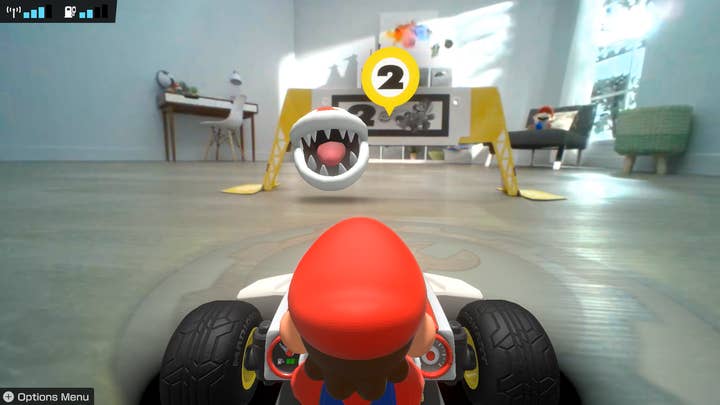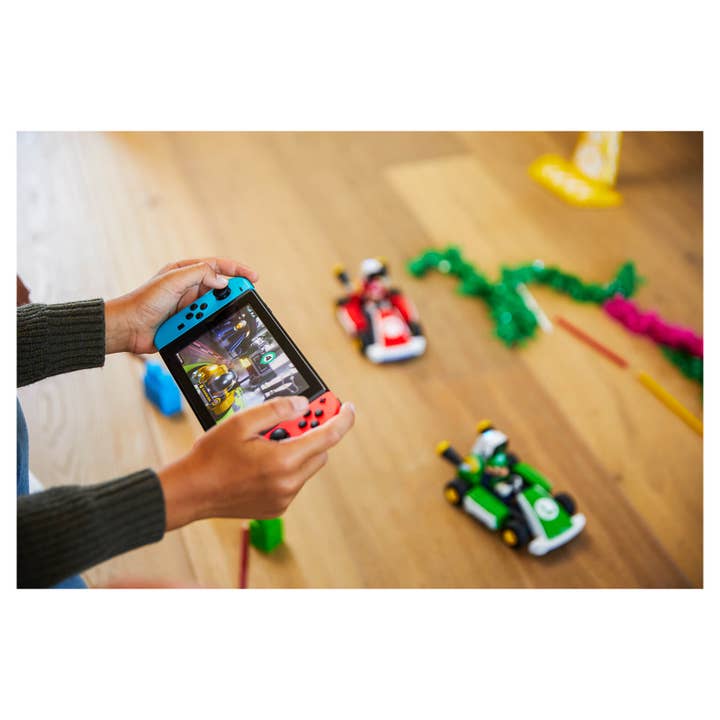Overcoming AR's limitations with Mario Kart Live: Home Circuit
Velan Studios president Guha Bala on reinventing Nintendo's best-selling racing franchise for augmented reality
It would be easy to classify Mario Kart Live: Home Circuit as the next step in the somewhat dormant toys-to-life market. After all, the remote control karts lie at the centre of the concept, pulling Mario Kart off the screen and onto your living room floor.
But it's the on-screen experience and the use of augmented reality that really mark a step forward.
It's probably fair to say that, unlike virtual reality, developers don't quite know what to do with its augmented counterpart. For all the initial hype around Pokémon Go being a huge moment of AR at launch, the game's appeal lay in its geolocation tech rather than its ability to put Pikachu on your kitchen table.
Like many augmented reality games, Pokémon Go's AR aspect centres around overlaying in-game objects onto the camera's view of the real-world but there is little to no interaction between the two. It's aesthetic, optional, and in the case of Pokémon Go, a drain on your battery so many players just turn it off.
Velan Studios, co-founded by Vicarious Visions' Bala brothers, believes it has found both the reason and a solution with Mario Kart Live.

"Each of these paradigms -- augmented reality and virtual reality -- have their own advantages and limitations," president Guha Bala explains on an upcoming episode of our Five Games Of podcast.
"For AR in particular, the way people have been visualising it is phone-based -- you point at something, and then you can render -- or as a headset-based thing, like Google Glass or Hololens. The phone-based stuff is pretty good with [Apple's] AR Kit but there's a use pattern where you have to hold it as you walk around, and there's a fatigue factor in doing that.
"And with head-tracking solutions, a lot of time the field of view is so narrow that it's more suited to enterprise applications, where you're using it for the utility of augmented reality as opposed to the amazing entertainment value. If it's your job, you can deal with those constraints, but if it's entertainment, you won't want to, you'll just want a good experience.
"With Mario Kart Live, reframing the question was important to us. We're not doing phone-based and we're not doing headset- based. We picked a problem we thought we could come up with a unique solution to that delivers an amazing experience."
That experience, as you will have seen from the trailer, separates the device handling the augmented reality aspect from the device presenting it. The remote control karts feature a camera that delivers a first-person view to Nintendo Switch, with the game adding enemies, items, and track markers on the screen. Using a boost, getting hit by a weapon, or anything else that impacts Mario affects the kart but doesn't impact the player, who remains free to play in handheld mode or docked on the TV in comfort as normal.
The idea originated from members of the Velan team with an interest in drone racing, and how competitors in this modern sport are simultaneously connected to and separate from their machine. Courses can take drone racers through courses no human-carrying craft could cope with, and while pilots can feel the thrill through the point-of-view video feed, they themselves are quite safe.
Velan Studios prototyped the idea and presented it to Nintendo, with whom the Balas have a long-standing relationship thanks to the myriad Game Boy Advance and DS titles that Vicarious Visions developed over the years. Nintendo was impressed, and Mario Kart Live is now a reality.
"There's a lot of hype around AR and VR, but either the vision is way ahead of what the technology can deliver or the price point is just too out of reach"
Part of the key to its appeal, says Bala, is that the team was realistic with what it could accomplish, not getting carried away with the possibilities, as can be common with augmented and virtual reality.
"There's a lot of hype around AR and VR, has been for years, but it's either been a case of the vision is way ahead of what the technology can deliver or the price point is just too out of reach for people," he says. "But with what we prototyped, we knew we could actually deliver something that's really magical, immersive, fun, and with super intuitive controls.
He adds: "We try to deliver for what's [possible] today, and that's really important from a games standpoint because the fantasy of the future is irrelevant to a person wanting to play a game."
Bala's reference to price does bring up Mario Kart Live's own costs -- each set is currently listed as £99.99 on Nintendo's online store -- but he explains there's "a lot going on in that kart, so it does drive the cost factor up."
"In that sense, the Starter Kit is not out of range -- there's a lot of value in that," he says. "It's a premium toy as well as an amazing game experience. That's in line with the pricing."
Velan Studios led much of the design and development of Mario Kart Live, even the hardware running at the heart of it all. It's a project that draws on experience from some of Vicarious Visions' biggest hits, such as various Guitar Hero outings -- including the DS version On Tour, with its guitar grip that plugged into the GBA slot -- and Skylanders.

It's the latter franchise where it's easy to draw a connection with Mario Kart Live. Currently only Mario and Luigi are available, but it's not a stretch of the imagination that Nintendo could produce other characters as remote control toys. Perhaps even future iterations will physically fire weapons, or have other unique features, like the Skylanders' Swap Force or Trap Team.
"This wasn't done with the plan of saying, 'How many additional accessories can we sell?'" says Bala when we suggest the comparison. "That would be a very typical business plan way of doing things. The way that this was done was more like, 'What's an amazing value for the consumer and how much can we give to them right now?' If people accept it and love it, of course it creates more opportunities but we focus on that first part."
Getting people to love a new games concept, particularly one that centres around physical products, can be difficult -- especially in 2020. The pandemic has cut off any option of consumer sampling or other experiential marketing activity. But Bala remains confident the appeal will come across as the product arrives on shelves tomorrow.
"Mario Kart Live is a new type of entertainment. It's one of those things where it's hard to describe the feeling of it without playing it," he says. "The video assets Nintendo has created have helped, but that thrill, the core driving experience, the creator experiences... If I described it to you, you'd be like, 'Well, that's interesting,' but you have to feel it.
He concludes: "We can do a certain amount with advertising and that kind of thing, but there are a lot of limitations this year. The best way to learn about these things is to have people buy it, love it, and recommend it, so hopefully we'll hear from users about it."
You can hear more from Guha Bala on next week's Five Games Of podcast, a spin-off series that explores the evolution of the games industry through the careers of prominent developers.


